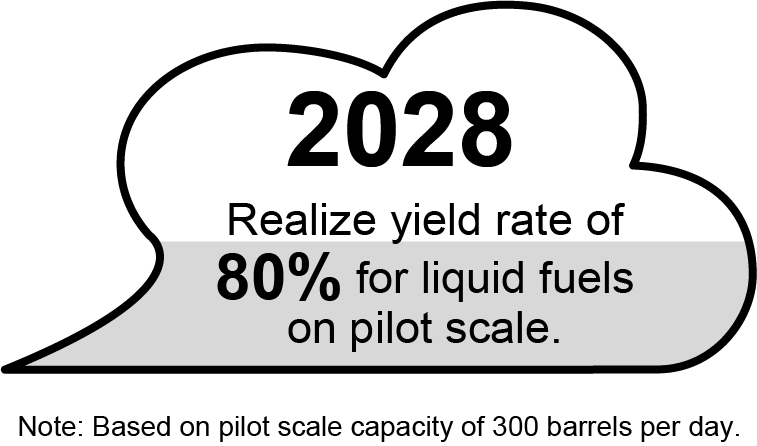
Project Summary
Budget
Up to 168.49 billion yen
CO2 Reduction Effect (World)
1. Liquid fuels for transportation
A. Synthetic fuels
- In 2030
- Approximately 45,000 tons/year
- In 2050
- Approximately 120 million tons/year
- In 2030
- Approximately 5.06-8.49 million tons/year
- In 2050
- Approximately 52.33 million tons/year
2. Gaseous fuels for industrial and household uses
A. Synthetic methane
- In 2030
- Approximately 900,000 tons/year
- In 2050
- Approximately 80 million tons/year
- In 2030
- Approximately 3,000 tons/year
- In 2050
- Approximately 64.5 million tons/year
Economic Effect (World)
1. Liquid fuels for transportation
A. Synthetic fuels
- In 2050
- Approximately 7.1 trillion yen/year
- In 2030
- Approximately 250 billion - 1.1 trillion yen/year
- In 2050
- Approximately 2.3 trillion yen/year
2. Gaseous fuels for industrial and household uses
A. Synthetic methane
- In 2030
- Approximately 20 billion yen/year
- In 2050
- Approximately 1.8 trillion yen/year
- In 2030
- Approximately 400 million yen/year
- In 2050
- Approximately 5.9 trillion yen/year
Research and Development Targets
1. Liquid fuels for transportation
Synthetic fuels
Enhance yield rate for liquid fuels.
In 2028:
Realize yield rate of 80% for liquid fuels on pilot scale.
Enhance yield rate for liquid fuels.
In 2028:
Realize yield rate of 80% for liquid fuels on pilot scale.

Enhance fuel utilization technologies.
In 2027:
In 2027:
- Realize technology for 50% reduction in CO2 emissions resulting from automobile fuel utilization.
- Develop technology for realizing net thermal efficiency of at least 55% in large vehicles.

Sustainable aviation fuels (SAF)
In 2030: Realize utilization of SAF for commercial aircraft operations with liquid fuel yield rate of at least 50% and production costs of less than 200 yen/L (between 100-199 yen/L).
In 2030: Realize utilization of SAF for commercial aircraft operations with liquid fuel yield rate of at least 50% and production costs of less than 200 yen/L (between 100-199 yen/L).
2. Gaseous fuels for industrial and household uses
Synthetic methane
FY 2030: Realize comprehensive energy conversion efficiency of more than 60%.
FY 2030: Realize comprehensive energy conversion efficiency of more than 60%.
Green LPG
In 2030: Commercialize production of at least 1,000 tons/year of LPG not derived from fossil fuels (development of synthesis technology with production rate of 30-50%).
In 2030: Commercialize production of at least 1,000 tons/year of LPG not derived from fossil fuels (development of synthesis technology with production rate of 30-50%).
Assumptions regarding estimates for CO2 reduction effect and economic effect
CO2 Reduction Effect
1. Liquid fuels for transportation
A. Synthetic fuels
- In 2030: Estimate of CO2 reductions in scenario where all synthetic fuel produced annually at plant with capacity of 300 BPD is used as substitute for diesel fuel.
- In 2050: Estimate of CO2 reductions in scenario where synthetic fuel is used as substitute for gasoline and diesel fuel and is calculated assuming demand decreases from 2021 onwards by annual rate of 2.4% for gasoline and 0.4% for diesel fuel.
B. Sustainable aviation fuels (SAF)
- In 2030: Estimate of SAF utilization by Japanese and international airlines departing from airports in Japan targeted for compliance with the Carbon Offsetting and Reduction Scheme for International Aviation (CORSIA).
- In 2050: Estimate of SAF utilization by Japanese airlines on domestic and international flights.
2. Gaseous fuels for industrial and household uses
A. Synthetic methane
- In 2030: Estimate calculated by assuming 1% of demand for city gas will be replaced by methanation. In this case, actual demand for city gas in 2019 is used.
- In 2050: Estimate calculated by assuming 90% of demand for city gas will be replaced by methanation. In this case, actual demand for city gas in 2019 is used.
B. Green LPG
- In 2030: Estimate of commercialized LPG production of 1,000 tons/year calculated by assuming combustion of LPG results in 3 times higher level of CO2 emissions.
- In 2050: Estimate calculated by assuming domestic LPG demand of 8 million tons/year is replaced by demand for green LPG and that demand for green LPG in Asian markets will total 13.5 million tons/year.
Economic Effect
1. Liquid fuels for transportation
A. Synthetic fuels
- In 2050: For fuel distribution, demand for synthetic fuels is expected to entirely replace demand for gasoline and diesel fuels. For fuel production facilities, construction of facilities that can accommodate demand for gasoline and diesel fuels is expected to begin in earnest after 2040.
B. Sustainable aviation fuels (SAF)
- In 2030: Estimate of utilization by Japanese and international airlines departing from airports in Japan targeted for compliance with CORSIA.
- In 2050: Estimate of utilization by Japanese airlines on domestic and international flights.
2. Gaseous fuels for industrial and household uses
A. Synthetic methane
- In 2030: Estimate calculated by assuming 1% of domestic demand for city gas will be replaced by synthetic methane and that target price of synthetic methane in 2050 will reach 50 yen/Nm3.
- In 2050: Estimate calculated by assuming 90% of domestic demand for city gas will be replaced by synthetic methane and that target price of synthetic methane in 2050 will reach 50 yen/Nm3.
B. Green LPG
- In 2030: Estimate calculated on basis of assumption that LPG is introduced into market at level of approximately 1,000 tons.
- In 2050: Estimate calculated on basis of assumption that domestic market demand for LPG will be replaced entirely by demand for green LPG, and also on the basis of the estimated amount of demand for green LPG in Asian markets.